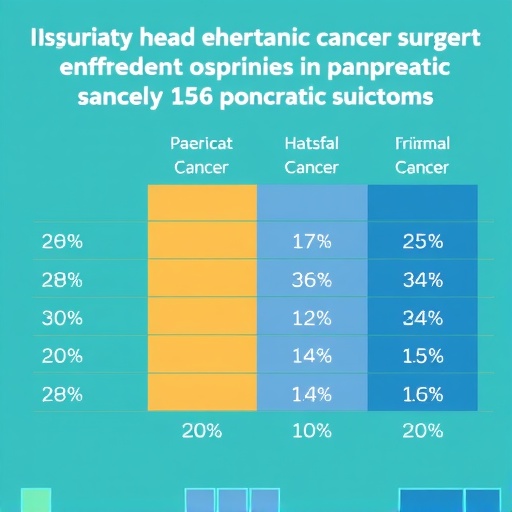
In the realm of oncology, pancreatic adenocarcinoma (PaC) remains one of the deadliest cancers, characterized by its aggressive nature and dismal prognosis. Despite advances in medical treatments, surgical resection stands as the primary curative approach for localized disease. However, a compelling new study emerging from a single, large academic center reveals stark racial and socioeconomic disparities in surgical treatment access and outcomes for PaC patients. This retrospective analysis, spanning over a decade and a half, sheds critical light on systemic inequities that continue to undermine equal healthcare delivery in modern clinical practice.
The investigation focused on a cohort of 525 patients diagnosed with pancreatic adenocarcinoma between 2010 and 2024. By meticulously examining patient demographics, tumor staging, surgical intervention rates, and survival data, researchers aimed to unravel the intricate association between race, socioeconomic status, and clinical outcomes. Socioeconomic status was inferred indirectly through zip code-based educational data, serving as a proxy to capture disparities influenced by educational attainment and associated economic factors.
Intriguingly, the study reported a significant divergence in surgical resection rates between African American and White patients. Despite comparable tumor resectability, only 20% of African American individuals underwent pancreatic resection compared to 36.1% of White patients. This disparity persisted even after controlling for clinical variables such as tumor stage and patient age, indicating that factors beyond disease severity play a pivotal role in determining access to life-saving surgery.
.adsslot_ziarhQmSd5{width:728px !important;height:90px !important;}
@media(max-width:1199px){ .adsslot_ziarhQmSd5{width:468px !important;height:60px !important;}
}
@media(max-width:767px){ .adsslot_ziarhQmSd5{width:320px !important;height:50px !important;}
}
ADVERTISEMENT
Advanced statistical modeling further substantiated these findings, with African American race associated with a 73% reduction in odds of receiving surgical treatment (odds ratio [OR] 0.27, p < 0.001). Additional detriments in surgical access were linked to increasing patient age and lower educational levels, underscoring the multifaceted nature of healthcare disparities. Patients presenting with more advanced staging—understandably less amenable to curative resection—exhibited an expectedly lower likelihood of undergoing surgery, confirming the robustness of the clinical data.
Survival analysis painted an equally concerning picture. On average, African American patients experienced shorter survival durations post-diagnosis, with mean survival times of approximately 406 days compared to 427 days for their White counterparts. Although this crude difference was statistically significant, it lost significance after adjusting for pertinent confounders such as tumor stage and receipt of surgical treatment. This nuance suggests that disparities in treatment access, particularly surgical intervention, may underlie survival discrepancies rather than intrinsic biological differences in tumor behavior.
The observed gap in surgical management speaks volumes about the structural barriers embedded within healthcare systems. Access to specialized pancreatic surgery is often contingent upon referral patterns, health literacy, proximity to tertiary centers, and implicit biases within clinical decision-making. Lower educational attainment, serving as a surrogate for socioeconomic disadvantage, compounds these inequities by limiting patients’ ability to navigate complex healthcare pathways effectively.
Given the critical role of surgical resection in prolonging survival for pancreatic adenocarcinoma, these disparities translate into tangible negative consequences for minority populations. While systemic chemotherapy and palliative care provide options for unresectable disease, surgical excision remains the cornerstone of curative intent. Thus, broadening equitable access to surgical evaluation and intervention emerges as a paramount priority.
This study also prompts reevaluation of public health strategies addressing cancer care delivery. Interventions designed to identify and dismantle barriers at multiple levels—including early diagnosis, referral networks, patient education, and perioperative support—could dramatically alter the trajectory of pancreatic cancer outcomes among underserved populations. Incorporating culturally sensitive patient navigation programs and enhancing provider awareness could initiate critical shifts toward equity.
Furthermore, the utilization of zip code-derived educational metrics highlights the utility of leveraging geographic and socioeconomic data in cancer research. These indirect measures enable comprehensive analyses where direct income or education information is unavailable, although they inherently carry limitations regarding granularity. Nonetheless, such tools remain indispensable in elucidating population-level health disparities.
From a methodological standpoint, the study’s reliance on a single-center dataset spanning 14 years offers both strengths and challenges. The depth of clinical information allows for detailed covariate adjustment rarely possible in population-based registries. However, single-institution findings may not be generalizable universally, warranting multicenter validation to confirm and expand upon these observations.
In sum, this retrospective investigation illuminates persistent racial and socioeconomic disparities within the surgical management landscape of pancreatic adenocarcinoma. African American patients and those from less-educated communities face significant obstacles in accessing potentially curative treatment modalities, contributing to survival inequities. These findings compel healthcare providers, policymakers, and researchers to intensify efforts toward eliminating bias and fostering equitable cancer care.
The implications extend beyond pancreatic cancer alone, serving as a stark example of the broader systemic challenges pervading oncology and healthcare delivery as a whole. Addressing these entrenched disparities requires a concerted, multidisciplinary approach that integrates clinical excellence with social justice. Only through such commitment can the promise of precision medicine and equitable treatment access be fully realized for all cancer patients.
This critical research arrives at a pivotal time when health equity is increasingly recognized as an indispensable component of quality care. Advanced analytics such as logistic regression and Cox proportional hazards modeling employed in this study enable nuanced understanding of multifactorial influences on patient outcomes. As the oncology community strives to close the gap in cancer disparities, rigorous data-driven studies like this provide the evidence base essential for transformative change.
Ultimately, reducing racial and socioeconomic barriers to pancreatic cancer surgery will demand innovation in healthcare systems, targeted community engagement, and policy reforms prioritizing vulnerable populations. The promise of improved survival and quality of life hinges on dismantling these gaps, ensuring patients receive care aligned not with their social standing but solely with their clinical needs.
In light of these findings, future research directions should include investigating underlying causes of referral disparities, patient perceptions of surgical care, and systemic biases. Combining qualitative insights with large-scale quantitative data can deepen understanding and guide effective interventions. Collaborative efforts across disciplines and institutions are vital to fostering health equity in pancreatic cancer and beyond.
As we continue to confront the complex interplay of biology, social determinants, and healthcare infrastructure in cancer outcomes, this landmark study serves as a clarion call to action. Equitable surgical management is both an attainable goal and an ethical imperative, central to improving survival for all patients battling pancreatic adenocarcinoma.
Subject of Research: Disparities in surgical management and outcomes of pancreatic adenocarcinoma with respect to race and socioeconomic status.
Article Title: Racial and socioeconomic disparities in surgical management and outcomes in pancreatic adenocarcinoma: a single-center experience in the last 13 years.
Article References:
Rosario Lora, D., Herrera Mercedes, S., Post, Z. et al. Racial and socioeconomic disparities in surgical management and outcomes in pancreatic adenocarcinoma: a single-center experience in the last 13 years. BMC Cancer 25, 1218 (2025). https://doi.org/10.1186/s12885-025-14588-w
Image Credits: Scienmag.com
DOI: https://doi.org/10.1186/s12885-025-14588-w
Tags: curative approaches for pancreatic adenocarcinomadisparities in surgical treatment for cancer patientseducational attainment and health disparitiesinequities in oncologypancreatic cancer surgery outcomespatient demographics and cancer outcomesracial disparities in healthcare accessretrospective analysis of cancer treatmentsocioeconomic factors in cancer treatmentsurgical resection rates in pancreatic adenocarcinomasurvival rates in pancreatic cancer patientssystemic inequities in healthcare delivery





